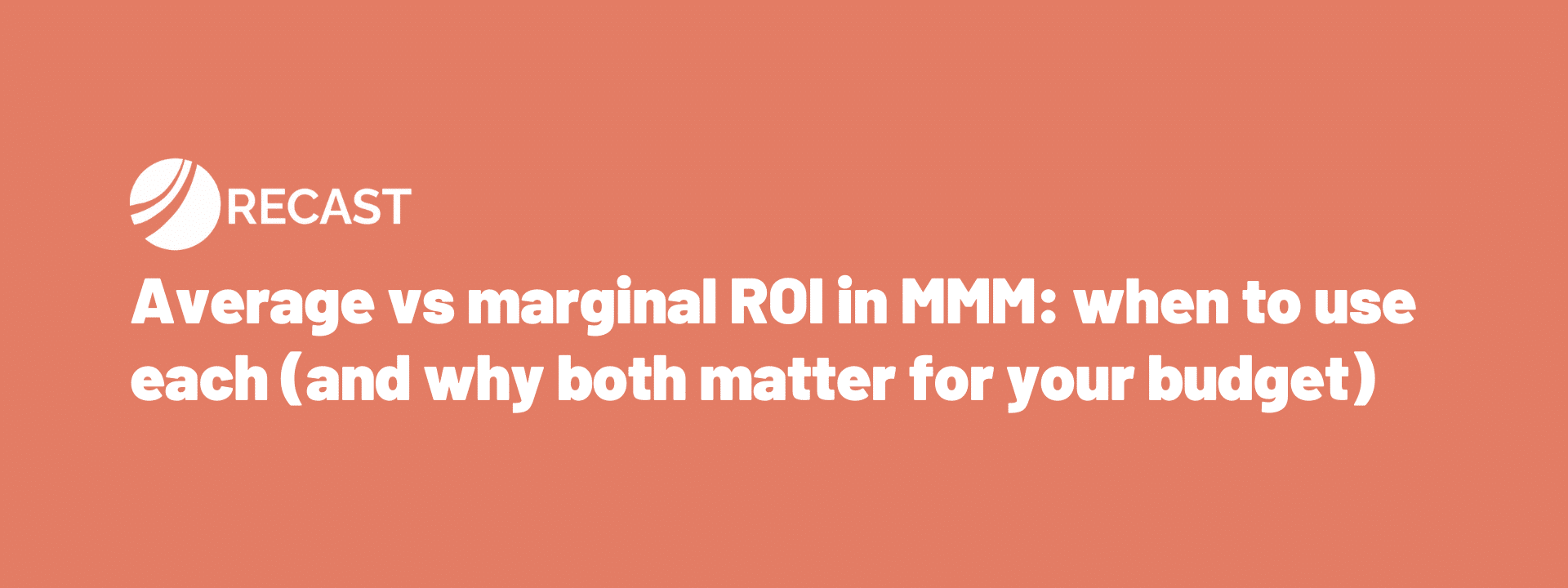It’s tempting to evaluate a channel by its average ROI.
If you spend $100,000 on Facebook and generate $200,000 in revenue, that 2× return looks great. But average ROI is a backward‑looking measure. It tells you how the last $100,000 performed — not how the next dollar will perform.
To optimize spend, you will need marginal ROI.
Say you spent $1M on Facebook ads and generated $2M in revenue. Your average ROI is 2×: $2M divided by $1M. But the marginal ROI of the millionth dollar might be only $0.50.
Marginal ROI answers the question: If I add another dollar to this channel, how much additional revenue will it drive?
It’s calculated as the derivative of the channel’s diminishing‑return curve at the current spend level. As channels saturate, response curves flatten, and each incremental dollar yields less.
So, a channel can have a higher average ROI but a lower marginal ROI if it’s already saturated.
In short, average ROI tells you how you’ve done so far.
Marginal ROI tells you where to put the next dollar.
Navigating misconceptions and balancing objectives
Even experienced marketers mix up these metrics or use them for the wrong goals.
Misconception #1: average ROI shows growth, marginal ROI shows profitability
There’s some truth to this: average ROI can be helpful if your primary objective is top‑line growth without losing money overall. Marginal ROI becomes more important when profitability is the priority.
But in practice, most companies operate with average ROI targets. They aim to maximize their spending while maintaining a blended ROI above a specified threshold.
Misconception #2: a higher average ROI means you should spend more there
Average ROI doesn’t help you decide how to shift budgets between channels. When you’re deciding whether to add $50,000 to Facebook or cut spend on TikTok, marginal ROI is the number that matters.
This is where we tend to see a very common mistake: chasing channels with higher average ROI even when their marginal ROI has already fallen.
Even if your goal is to maximize average ROI, you get there by allocating incremental spend to channels with the highest marginal ROI until their returns equilibrate. You’d never shift budget into a channel with a higher average ROI but a lower marginal ROI because the incremental dollar would work harder elsewhere.
Misconception #3: ROI and CPA are the same thing
Another point of confusion: ROI versus CPA. If your KPI is acquisitions, ROI becomes “acquisitions per investment,” and CPA is its inverse: “cost per acquisition.”
Translating between ROI and CPA can be a headache, but the principle is still that marginal metrics drive better decisions about incremental spend while knowing which channels are saturated and which still have room to scale
Stakeholders often prefer average ROI because it’s intuitive and aligns with reporting needs: “We spent $100,000 and got $200,000 back.” But operationally, nearly every decision you make happens at the margin.
Balancing both metrics: reporting vs. action
We do want to make this clear: while it’s tempting to declare marginal ROI the only metric that matters, that would ignore the broader business context.
Average ROI still plays an important role in evaluating a program’s effectiveness.
Stakeholders — executives, finance teams, boards — care about average ROI because it summarizes overall performance. It gives you a simple story: “we spent $1M and got $2M.”
Marginal ROI, on the other hand, isn’t a reporting metric — it’s an action metric. It guides where to put the next dollar — or whether the next dollar is worth spending at all.
The key is using each metric for its intended purpose:
- Average ROI evaluates program effectiveness and communicates results.
- Marginal ROI drives allocation decisions and optimizes spend.
As a marketer, you should distinguish between these metrics and apply each to the right objective — profitability, growth, or efficiency — so you can avoid misaligned incentives with the wrong metrics.
Start by modeling response curves to understand saturation and incremental returns across channels. Use marginal ROI to guide incremental spend, but still keep an eye on your average ROI to make sure you’re reporting on what your stakeholders care about.
Recap: when to use average vs marginal ROI (and why both matter) 🔁
- Average ROI shows how past spend performed. It’s great for reporting and summarizing program performance.
- Marginal ROI shows how the next dollar will perform. It’s essential for budget allocation and optimizing spend.
- Even experienced marketers confuse the two — but marginal ROI is what drives smarter decisions in real-time.
- To scale efficiently, model response curves, watch for saturation, and use marginal ROI to guide future investment.
- Stakeholders want big-picture ROI. Marketers need action-ready ROI. Use both – just use them for the right job.



